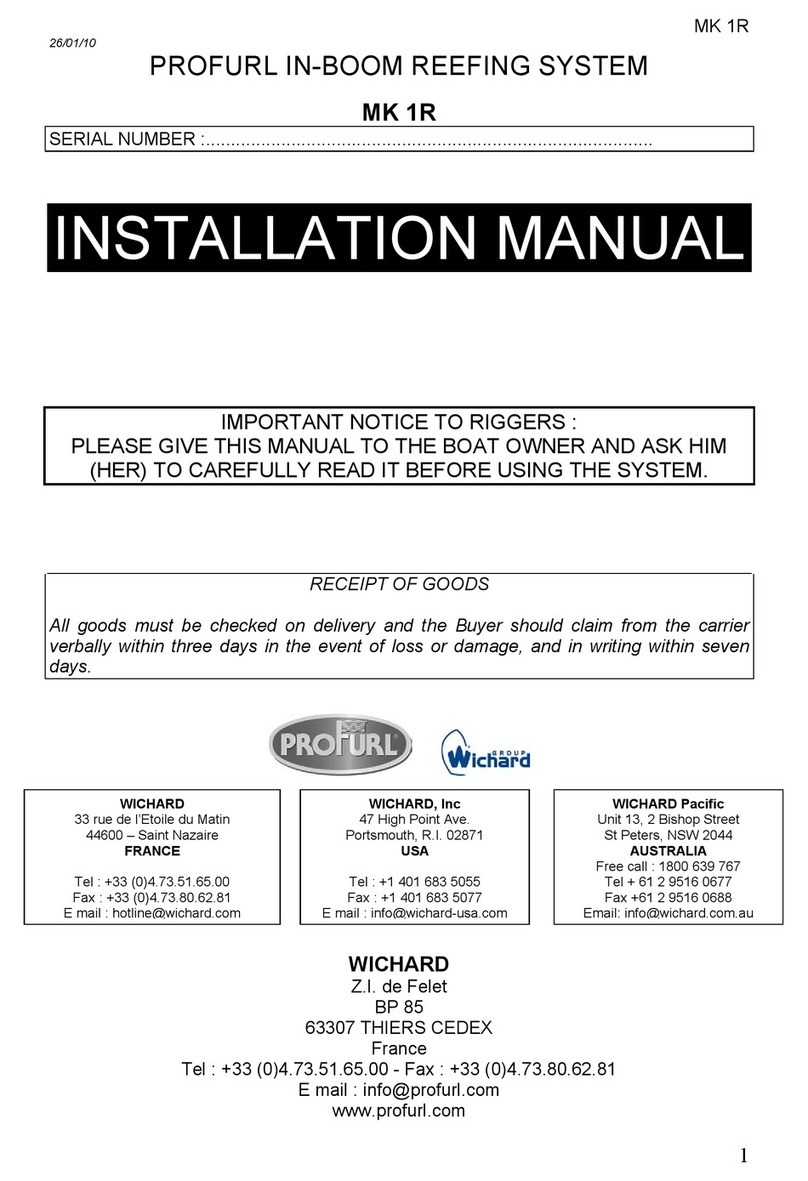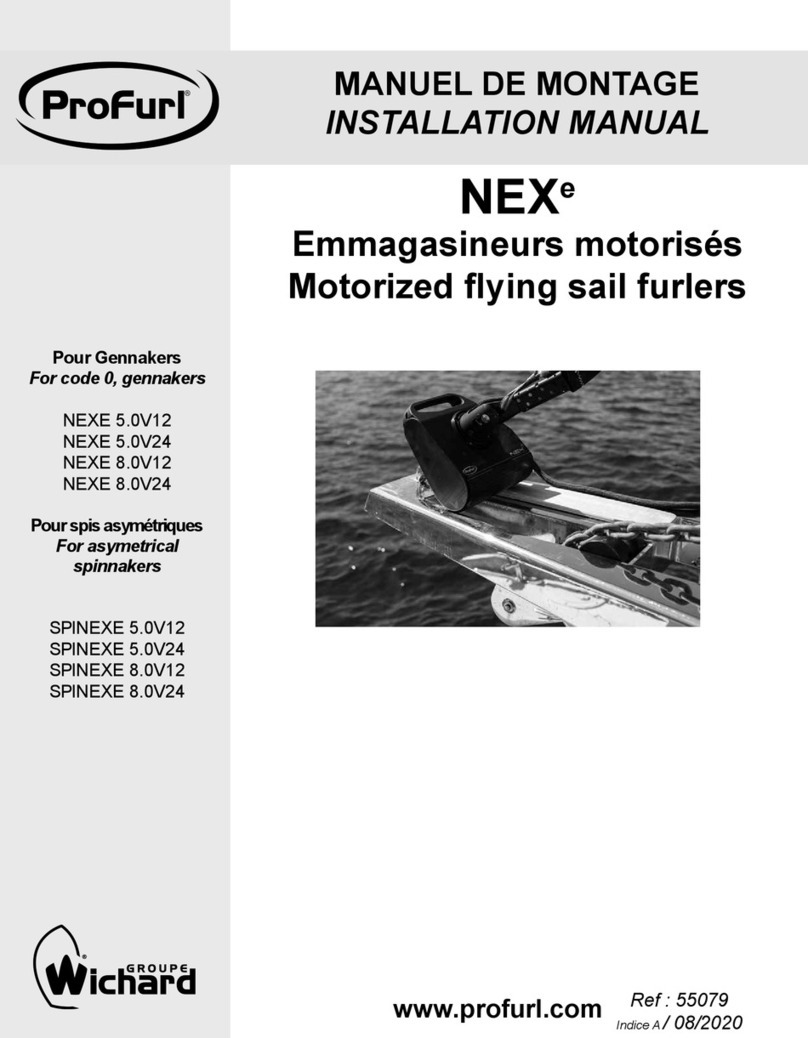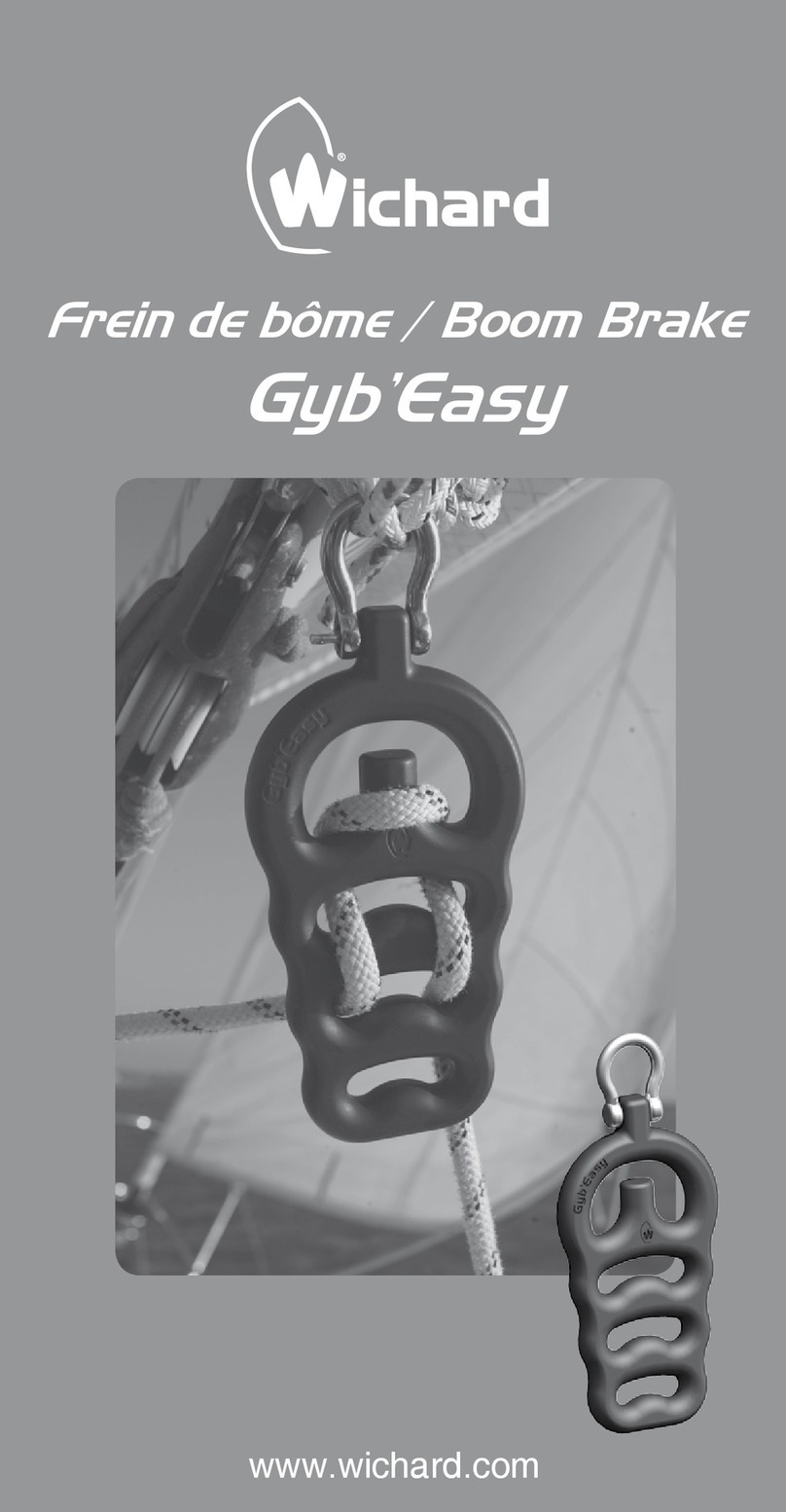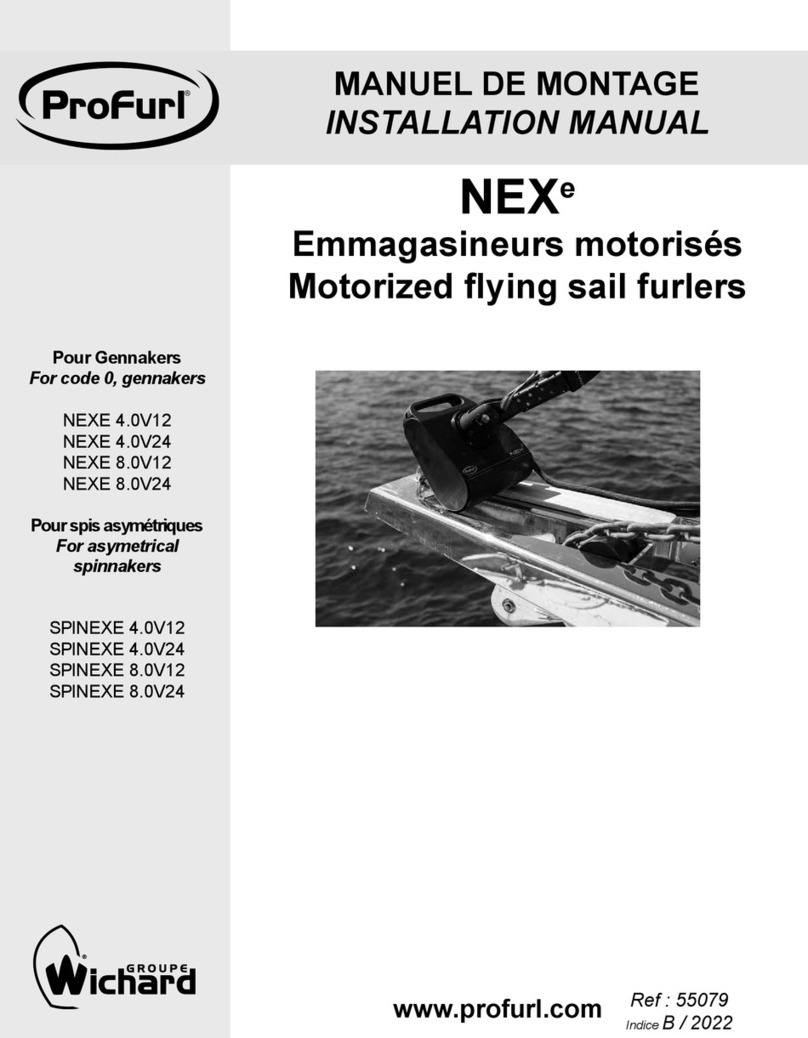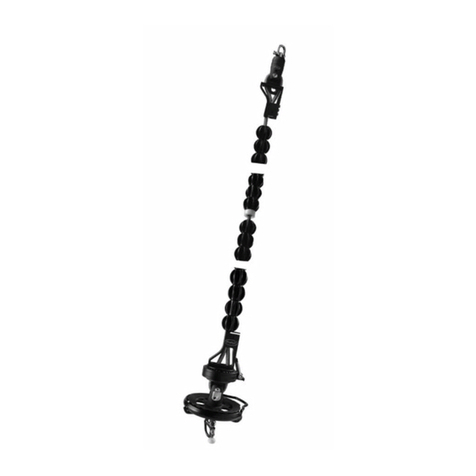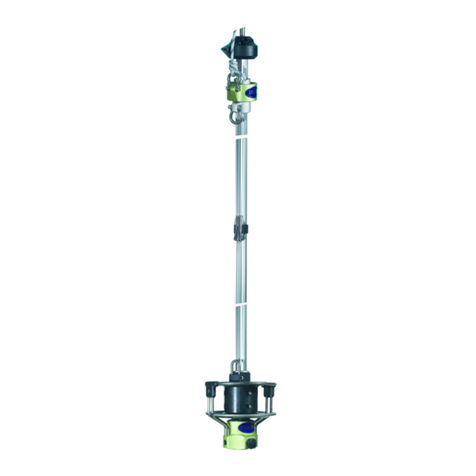FRANCAIS
I) INTRODUCTION:
Vous venez d’acquérir Gyb’Easy le nouveau frein de bôme Wichard, nous vous remercions de l’intérêt et de la
confiance que vous portez à nos produits et espérons que celui-ci vous apportera la plus grande satisfaction.
1) Principe de fonctionnement:
Le frein de bôme Gyb’Easy utilise un cordage spécifique Gyb’Flex passant dans une ou plusieurs de ses ouver-
tures. Les caractéristiques du cordage et sa friction sur le frein assurent un freinage de la bôme en souplesse.
La progressivité du freinage évite toute fausse panne et retard à l’empannage. En navigation, le contrôle de
l’empannage se fait par la tension du cordage (sans aucune action sur l’écoute de grand-voile).
2) Réglages de Gyb’Easy :
3 positions de pré-réglages sont possibles (voir page 3 photos 5, 6 et 7) pour s’adapter aux surfaces de
grand-voile jusqu’à 40 m² et aux changements importants des conditions de navigation (ex : passage de force
3 à 6). Plus le nombre de passages est important, plus le freinage sera puissant. Comme pour tout frein de
bôme, quelques essais sont nécessaires pour bien ressentir le fonctionnement du système. Une fois le bon
pré-réglage trouvé, le réglage en navigation se fait directement du cockpit par la tension du cordage (prévoir
l’utilisation d’un winch ou d’un palan). Si une tension trop importante du cordage est nécessaire au bon freinage
de la bôme, utiliser la position de pré-réglage supérieure.
3) Limites de fonctionnement, entretien et précautions d’usage:
Limites de fonctionnement: Gyb’Easy a été conçu pour les grand-voiles jusqu’à 40 m².
ATTENTION: Son bon fonctionnement n’est garanti qu’en utilisant le cordage Gyb’Flex fourni. En cas de chan-
gement de celui-ci, il est impératif de réutiliser le même type cordage (réf Wichard 7148). Pour cela, veuillez
vous rapprocher de votre revendeur. Afin de garantir votre sécurité et le bon fonctionnement du frein de bôme,
veuillez surveiller régulièrement l’usure du cordage. Il est recommandé de changer ce cordage tous les 5 ans.
Entretien: Gyb’Easy ne requiert aucun entretien particulier. Toutefois il est conseiller de rincer le frein et le
cordage régulièrement à l’eau claire et en cas d’hivernage prolongé, de les démonter.
Précautions d’usage: ATTENTION, même avec un frein de bôme il est tout de même nécessaire de prendre
un ris lorsque les conditions de vent l’exigent. Le cordage Gyb’Flex doit être uniquement utilisé pour cette
fonction et en aucun cas pour un autre usage (écoute, drisse...).
II) INSTALLATION:
IMPORTANT : L’installation du système doit toujours être symétrique à l’axe longitudinal du bateau.
1) Installation recommandée avec deux retours au cockpit: voir page 2 schémas 1 et 2
Etape 1 : Installation des poulies de renvoi (B):
Frapper les deux poulies de renvoi (B) suivant le schéma 1 (ex: sur les cadènes de bas hauban arrière). Poulies
Wichard réf 63105 (poulie Ø45 jusqu’à 20 m² de GV) ou réf 64105 (poulie Ø55 au-delà de 20 m² de GV).
Etape 2 : Installation du Gyb’Easy (G):
Fixer le Gyb’Easy (G) sur un pontet sous la bôme en arrière du hale-bas suivant les schémas 1 et 2.
Attention, dans tous les cas, la longueur AG doit être sensiblement égale aux longueurs AB. En l’absence de
pontet il est possible de fixer le frein avec un brêlage et une retenue pour éviter le glissement du frein vers
l’avant. Toutefois l’installation d’un pontet est recommandée.
Etape 3 : Installation du cordage Gyb’Flex:
Passer le cordage Gyb’Flex dans l’un des bloqueurs du cockpit ou directement sur un winch. Le passer ensuite
dans les 2 poulies de renvoi (B), puis le renvoyer sur le bloqueur opposé ou directement sur un winch. Assurez-
vous que rien ne vienne gêner le passage du cordage.
Etape 4 : Passage du cordage dans le frein:
Passer une boucle du cordage dans le frein de bôme (voir page 3 photos 5, 6, 7).
Etape 5 : Coupe du surplus de cordage:
Reprendre le mou du cordage, faire 3 tours sur les winchs, garder au minimum 1m après les winchs et si né-
cessaire recouper le surplus de cordage et conserver le reste comme cordage de rechange.
2) Autre possibilité d’installation avec un seul retour au cockpit: voir page 3 schémas 3 et 4
Dans le cas ou l’implantation recommandée n’est pas envisageable, il est possible d’installer le frein de bôme
avec un seul retour au cockpit. Toutefois ce type d’installation nécessite plus de précision de réglage à l’instal-
lation, offre moins de souplesse au freinage et est moins adapté aux grand-voiles de petite taille.
Dans ce cas, le cordage Gyb’Flex ne retourne pas au cockpit, c’est un cordage marin ‘’standard’’ (non fourni)
monté en palan qui permet de régler la tension à partir du cockpit.
Etape 1 : Choix des points d’ancrage (F) du cordage Gyb’Flex:
ex: cadènes de bas hauban arrière (schéma 3).
Etape 2 : Installation des poulies (C):
Fixer la poulie C1 sur un pontet sous la bôme en arrière du hale-bas puis la C2 au pied de mât suivant le
schéma 4. Poulies Wichard réf 64105 (poulie Ø55 jusqu’à 20m² de GV) ou réf 65105 (poulie Ø70 au-delà de
20m² de GV). Attention, dans tous les cas, la longueur AC1 doit être sensiblement égale aux longueurs AF. En
l’absence de pontet il est possible de fixer le frein avec un brêlage et une retenue pour éviter le glissement du
frein vers l’avant. Toutefois l’installation d’un pontet est recommandée.
Etape 3 : Installation du cordage de commande ‘’standard’’:
Frapper un cordage ‘’standard’’ à la manille du frein de bôme, le faire passer dans les poulies C1 et C2, puis le
faire revenir au cockpit sur un bloqueur ou directement sur un winch. Voir schéma 4.
Etape 4 : Positionnement du frein de bôme Gyb’Easy:
A l’aide du cordage de commande, positionner le frein Gyb’Easy de façon à laisser une course de tension
d’environ 30cm (variable en fonction de la taille du bateau). Voir schéma 4.
Etape 5 : Installation du cordage Gyb’Flex:
Fixer une extrémité du cordage Gyb’Flex au point d’ancrage bâbord, passer une boucle du cordage dans le frein
de bôme en position 1 (voir photo 5), reprendre le mou du cordage et faire un nœud provisoire sur le point d’an-
crage tribord. La distance (d) entre Gyb’Easy et la poulies C1 doit être d’environ 30 cm (variable selo les bateaux)
pour permettre la tension du cordage Gyb’Flex. Quelques empannages sont nécessaires pour être sûr d’avoir
suffisamment de course de réglage (d) et pas trop de distance entre le frein et la bôme. Voir schéma 4.






